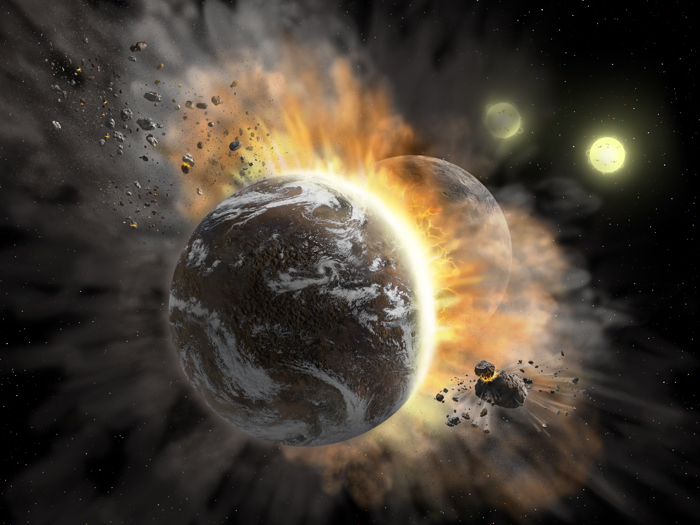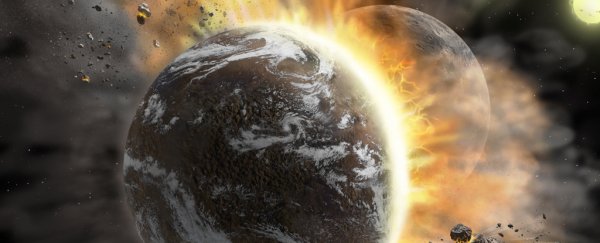BD +20 307 should not have been so bright. For such an old binary star system, it should have appeared cool in our scopes. Instead, it looked hot.
The discovery of this, made over a decade ago, signalled to astronomers that something incredible had happened: BD +20 307, a solar system over 300 light-years from Earth, was the scene of a violent cosmic accident.
Exactly what had taken place was up for debate, but it was definitely something powerful enough to spew out a hot, cloudy aftermath of swirling dust and debris encircling the distant star system in a giant ring.
Early analysis suggested asteroids or planetesimals running into one another may have been the cause. Subsequent spectroscopic observations refined the hypothesis, and then in 2010, scientists concluded the excess of dust we were seeing was, in all likelihood, the result of actual worlds colliding.
That giant dust bowl surrounding BD +20 307? Countless tiny fragments left behind by two dead exoplanets that just couldn't avoid each other in all the vast emptiness of space.
 Artist's impression of worlds colliding in BD +20 307. (NASA/SOFIA/Lynette Cook)
Artist's impression of worlds colliding in BD +20 307. (NASA/SOFIA/Lynette Cook)
"A catastrophic collision of two rocky, planetary-scale bodies in the terrestrial zone is the most likely source for this warm dust," astronomers explained in a paper, acknowledging that evidence of such "cataclysmic impacts" was rare.
Rare they may be, but simulations suggest these run-ins do occur. For what it's worth, you might only be reading this because our own planet once had such an encounter. The Moon, perhaps, was another beneficiary.
Regardless of local history, the hypothetical explanation for what transpired far away in BD +20 307 just got supported by a new study led by astrophysicist Maggie Thompson from the University of California, Santa Cruz.
Most spectacularly of all, the new research indicates that in the past decade or so since the last observations, the hot, dusty legacy of this violent collision seems to have gotten either hotter or dustier.
New infrared readings taken with SOFIA (the Stratospheric Observatory for Infrared Astronomy) and its Faint Object Infrared Camera indicate the luminosity of the dust ring 300+ light-years away has actually brightened about 10 percent in recent years.
That's a significant burst in brightness, and it could mean there's more dust grains absorbing more heat from the starlight of BD +20 307's two stars – or it could mean something else has happened to heat the same amount of dust up to a hotter temperature (such as hotter or closer stars), although such developments are extremely unlikely in a short timeframe of only years.
If the former eventuality is true – and the surface area of the dusk disk visible to us here on Earth is somehow greater – it might mean the chaotic, billowing fallout from the two worlds colliding is still unfolding.
It's an intriguing possibility, although the team notes we don't have enough evidence to know for sure just why this luminosity flux exists.
On all the data available, the researchers maintain the collision between planetary-scale bodies is "still the most likely origin for the system's extreme dust", but BD +20 307's strange brightening warrants plenty more investigation yet.
"The warm dust around BD +20 307 gives us a glimpse into what catastrophic impacts between rocky exoplanets might be like," Thompson says.
"We want to know how this system subsequently evolves after the extreme impact."
The findings are reported in The Astrophysical Journal.
